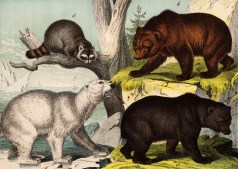The Impact of Climate Change on Polar Bear Populations: What You Need to Know
Polar bears, iconic symbols of the Arctic, are facing unprecedented challenges due to climate change. As the planet warms and sea ice melts at alarming rates, understanding the status of polar bear populations has never been more crucial. This article delves into how climate change affects these majestic creatures and what it means for their future.
Current Status of Polar Bear Populations
As of now, polar bear populations are classified into 19 distinct subpopulations across the Arctic region. The International Union for Conservation of Nature (IUCN) lists them as vulnerable, with some populations experiencing severe declines. Factors such as habitat loss, decreased sea ice extent, and changes in prey availability are contributing significantly to population stress. In areas like Alaska and Canada, specific subpopulations have shown marked declines due to these environmental changes.
Effects of Climate Change on Habitat
Climate change is primarily influencing polar bear habitats through the rapid melting of sea ice. Polar bears rely on this ice not only for hunting seals but also as a platform for breeding and resting. With temperatures rising faster in the Arctic than anywhere else on Earth, scientists estimate that summer sea ice could disappear entirely by mid-century if current trends continue. This loss directly impacts polar bear survival rates and reproductive success.
Prey Availability and Nutritional Stress
As changing climates affect marine ecosystems, polar bears find themselves struggling with access to their primary food source: seals. The decline in sea ice leads to a decrease in seal populations since many species rely on stable ice conditions for pupping and nursing their young. As a result, polar bears face nutritional stress during critical seasons when they need to build fat reserves before hibernation.
Conservation Efforts Underway
In response to these challenges, several conservation efforts are being implemented globally. Organizations such as WWF (World Wildlife Fund) work towards protecting critical habitats through policy advocacy and community engagement initiatives focused on sustainable practices. Additionally, research programs aimed at tracking polar bear movements help scientists understand their responses to environmental changes better.
What You Can Do
Every individual can contribute to the welfare of polar bears by advocating for climate action within communities or supporting organizations dedicated to wildlife conservation. Simple actions like reducing carbon footprints—using renewable energy sources or conserving energy in daily life—can collectively make a significant impact on global warming trends affecting these majestic animals.
Understanding the status of polar bear populations amidst climate change is essential not only for their survival but also for maintaining biodiversity in our planet’s ecosystems. By staying informed and taking action together, we can help ensure that future generations will know these magnificent creatures thrive in their natural habitat.
This text was generated using a large language model, and select text has been reviewed and moderated for purposes such as readability.


